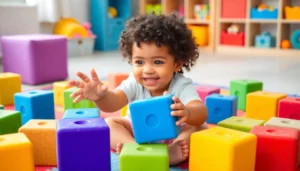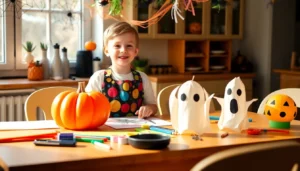Navigating the world of divorce is like trying to assemble IKEA furniture without the instructions—confusing and often frustrating. When kids are involved, the stakes get even higher. Suddenly, it’s not just about who gets the couch or the cat; it’s about co-parenting, schedules, and managing emotions that can rival a soap opera.
Navigating Divorce With Children
Navigating divorce with children presents unique challenges that require careful consideration. Co-parenting arrangements, including schedules and communication methods, play a significant role in ensuring a child’s well-being. Establishing a routine helps children maintain stability during transitions, so consistent visitation times benefit all parties involved.
Managing heightened emotions can complicate interactions. A positive attitude from both parents fosters a cooperative atmosphere. Clear communication regarding expectations and responsibilities eases tensions. Utilizing mediation services can assist parents in reaching agreements without conflict.
Legal requirements differ by state, so familiarizing oneself with custody laws is crucial. Most jurisdictions focus on the child’s best interests when determining custody arrangements. Parents should document their interactions and any agreements in writing to avoid misunderstandings.
Support systems also matter. Encouraging children to express their feelings provides an outlet for processing changes. Accessing professional counseling can help children and parents alike navigate emotional hurdles. Schools can offer additional support resources for children adjusting to new family dynamics.
Finding a balance between personal emotions and parental responsibilities is essential. Practicing self-care can improve interpersonal relationships during this challenging period. Building a strong, collaborative co-parenting relationship will ultimately benefit the child and contribute to a healthier post-divorce life for everyone involved.
Understanding Your Rights

Navigating divorce with a child brings specific rights and responsibilities that parents must understand. Knowledge in these areas helps establish fair arrangements for everyone’s benefit.
Custody Arrangements
Custody arrangements determine where a child resides after divorce. Legal custody grants a parent the authority to make significant decisions about the child’s education and healthcare. Physical custody relates to the child’s living situation. Parents can share joint custody, where both are involved in decision-making and raising the child. Alternatively, one parent may have sole custody, which impacts visitation rights for the other. Courts prioritize the child’s best interests when deciding custody arrangements, assessing factors like the child’s relationship with each parent and their overall emotional and physical well-being.
Child Support Responsibilities
Child support establishes financial assistance to ensure a child’s needs are met. Obligated parents contribute regularly to cover living expenses, education, and healthcare costs. Calculating support amounts often relies on parents’ incomes, the child’s needs, and state guidelines. Courts enforce child support orders to guarantee payments. Parents seeking assistance can access state agencies for enforcement or modification of support agreements. Understanding these responsibilities contributes to a healthier post-divorce atmosphere for children.
Emotional Impact on Children
Divorce profoundly affects children, triggering a range of emotional responses. Navigating these emotions can be challenging, but understanding them is crucial for parents.
Age-Related Reactions
Infants may sense parental distress, leading to increased clinginess or disrupted sleep patterns. Toddlers often exhibit confusion and may regress in behavior, such as saying “no” more frequently. Preschool-aged children could worry about separation, asking questions about living arrangements. School-age children frequently become aware of conflict, leading to anger or guilt. Teenagers might display rebellion or withdrawal, as they struggle with their own identities alongside family changes. Recognizing these age-specific reactions helps parents respond compassionately.
Coping Strategies for Kids
Establishing routines provides children with a sense of security. Encouraging open conversations allows them to express feelings freely. Engaging in activities, such as sports or art, helps redirect energy positively. Introducing counseling can offer a safe space for children to process emotions. Practicing mindfulness exercises equips kids with tools to manage anxiety. Connecting with peers supports their emotional needs, as friendships provide comfort during transitions.
Co-Parenting Effectively
Co-parenting after divorce requires clear communication and established boundaries to support the child’s well-being and stability.
Communication Techniques
Effective communication minimizes misunderstandings and conflicts. Prioritize open dialogue where both parents can express their thoughts. Use text messages or emails for non-urgent matters to maintain a record. Schedule regular check-ins to discuss the child’s needs and any upcoming events. Stay focused on the child’s best interests during conversations. Avoid bringing up past grievances; instead, emphasize current challenges and solutions. Utilize collaborative tools like shared calendars to keep track of parenting responsibilities. Engaging in a respectful tone fosters cooperation and sets a positive example for the child.
Setting Boundaries
Setting clear boundaries creates a stable environment for the child. Define each parent’s responsibilities, including decision-making about education and healthcare. Outline visitation schedules to ensure consistency. Avoid overstepping boundaries; respect each parent’s time and space. Children benefit from knowing what to expect from each home. Clarify roles in co-parenting to prevent confusion regarding authority. Consistently enforce rules at both homes, reinforcing a sense of security for the child. Establish boundaries around communication styles, ensuring conversations remain respectful and productive.
Legal Considerations
Navigating legal aspects during a divorce with a child involves understanding key elements such as filing procedures and the choice between mediation and litigation.
Filing for Divorce
Filing for divorce initiates the legal process, requiring one party to submit a petition to the court. State-specific rules dictate the necessary documentation and residency requirements. Forms typically include the divorce petition and, if applicable, a request for custody and support arrangements. Complying with state laws ensures a smoother process and reduces potential delays. Parents often face timelines that include waiting periods and court schedules, making it crucial to stay informed and prepared. Gathering essential documents, such as financial records and parenting plans, supports effective filing.
Mediation vs. Litigation
Mediation serves as a collaborative approach for couples seeking to navigate divorce amicably. This process involves a neutral third party facilitating discussions about custody, visitation, and support agreements. Couples often find mediation less adversarial and more cost-effective than litigation. Litigation, on the other hand, leads to court involvement, where a judge makes binding decisions regarding custody and support. Parents may experience more uncertainty with litigation due to its formal nature and potential for prolonged conflict. Weighing the options between mediation and litigation allows parents to select the path aligned with their child’s best interests and overall family dynamics.
Navigating divorce while raising a child presents unique challenges that require careful consideration and planning. Establishing a solid co-parenting framework and understanding legal obligations are vital for fostering a supportive environment. Parents must remain aware of their child’s emotional needs and adapt their approaches as necessary.
By prioritizing open communication and setting clear boundaries, parents can create a stable atmosphere that promotes their child’s well-being. Embracing support systems and practicing self-care will not only benefit the child but also contribute to healthier co-parenting dynamics. As parents move forward, their commitment to collaboration and understanding will play a crucial role in ensuring a positive outcome for everyone involved.





